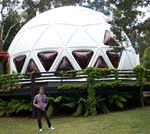Having the opportunity as a youngster to spend my summers in the forests and lakes of Northern Michigan I'm sure has affected what I'm doing right now. I remember being in the forest and playing with sticks, assembling them, and liking the feeling of being with the trees.
Wood designer-maker John Smith

I came to Australia in 1970 to take up a teaching position at the Tasmanian School of Art. We were probably some of the last of the Ten Pound Poms. I was very keen after going through college in the UK to travel overseas and try other cultures.

We came to Australia initially with the idea of staying for a couple of years and then moving to America. But the longer we stayed the more we liked it. Particularly identifying with the natural environment, the bush, the clean air and the easy lifestyle that Australia is. I found that very stimulating and the relative freedom to design and build with fewer restrictions than would have been the case in the UK.
When I came here in 1970, it was about the time or just before when wood chipping began. Wood chipping began as a very sensible, efficient use of the forest resource in terms of using the waste that would otherwise just be lost in the process of getting the good timber. Since then it's grown and grown and has become the dominant reason for going into the forest. So we're losing our old growth forests at a rapid rate, losing the quality natural environment and selling the valuable timber for prices that really are unsustainable.
I get my ideas from a range of sources. But I suppose the most predominant one would be architecture. Mainly because architecture is looking at a whole range of materials, approaches, scale, the sense of space, relationship to inside and outside and all of those things I can relate back to furniture as a smaller scale of architecture. There's a point at which the interface between people and buildings occurs, from the cabinets, the chairs, the doorknobs, all the actual points of contact which are at more of a human scale, that you can relate to, which is why I bring those influences back into furniture.
The last few years I've concentrated mostly on cabinets again mainly because they're an easy metaphorical reference to architecture but I also find the chair a very stimulating and demanding - perhaps the most demanding piece of furniture. Because of the ergonomic and structural requirements the chair must fulfil. And also the great variety of forms one can choose.
Comfort is much more than physical comfort. It's surprising how many people will buy furniture that they feel visually, psychologically, emotionally comfortable with. And the actual physical comfort, while it has to be adequate, does not have to be that great. I mean otherwise we'd be sitting on great lumps of foam rubber all the time, if it was absolute comfort we wanted. I think that the relationship to the chair is quite a cultural history. There's a lot of status associated with chairs going right back to thrones and things like that. But also if you consider that the chair gets sat in perhaps one percent of the time. The rest of the time it sits there in the space, saying something about the chair, about the act of seating, and about the lifestyle and particular functions associated with it, depending on what kind of chair it is.
Related
I'm a self-taught wood turner. That didn't satisfy me in some way, there was something missing. So I toddled off to the Canberra School of Art and spent a couple of years there doing a furniture-based wood course.
I turned to furniture mid-career. I was actually trained as a musician and a high school teacher and I decided to do something else. I'd done a lot of building before and I suddenly decided to build stuff that I was going to sell instead of keep.
About fifteen years ago I bought a little house that I was going to renovate but I could never find anyone to do things exactly as I wanted them.
I was born in Melbourne and I've been in Tasmania for about 14 years. I like Tasmania because I like the bush, I like the weather, I like the timber. It's a much more natural environment than the mainland. The landscape here is inspirational to my work.
My workshop is on part of the family farm and I've lived alongside it or near it all my life apart from the occasions where I've been studying or working overseas or interstate.
I was born in Tasmania. My father was in the timber industry so I was always surrounded by stories of timber and things like that. I left school at 14 to do a trade in joinery. Prior to that I was more interested in making boats.
I remember carving when I was about 8. I used to steal my mum's lino carving tools. I was able to go down to the workshop in the garage and carve away. I think the first thing I came up with was an acanthus leaf. I was really pleased with that.








